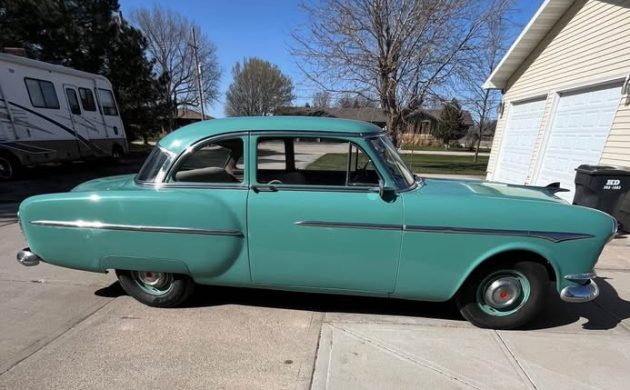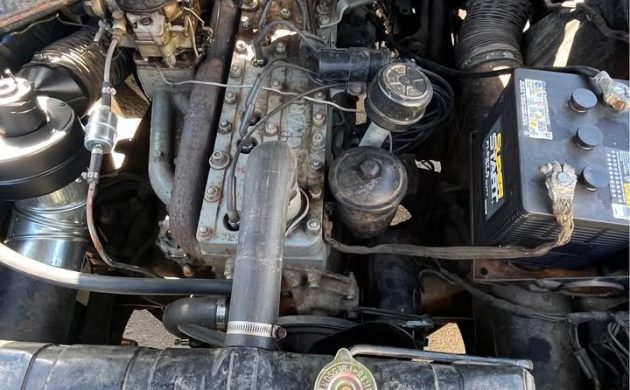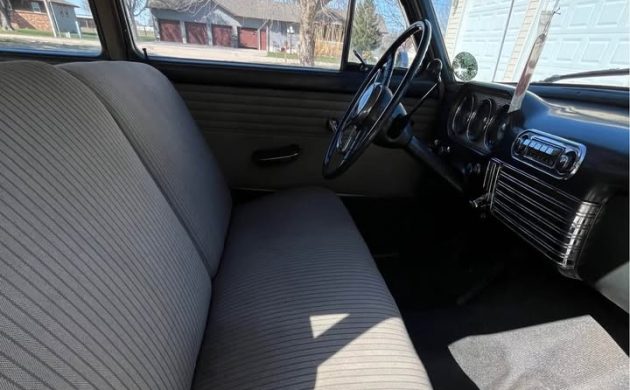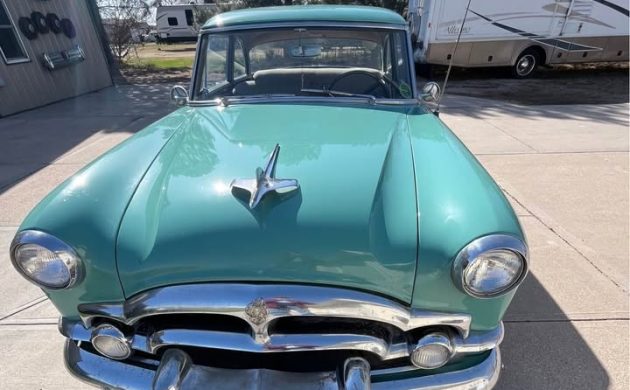Packard’s Clipper was produced in three tranches, beginning in the pre-war period. The 1941 Clipper was one of the last completely new designs from any car company before the war started, looking completely unlike any Packard before it. The design was at least partially influenced by Dutch Darrin, who had been constructing customized Packards since 1937. With flowing fenders and a long hood, the styling struck a chord with the public. The Clipper outsold the popular One-Twenty line despite costing nearly the same as Cadillac’s lowest-priced model. After the war, Packard picked up where it left off, but not until 1946, when all of its production was called “Clipper”. Another hiatus ensued from 1948 to 1952 as the company trialed “bathtub” styling; its failure put a dent in the company’s finances, which had begun to decay with management’s strategy gyrations. In 1952, management changed tactics again, attempting to recapture the Clipper’s early success by proposing a standalone division for the model. Dealers cried foul, and the Clipper came to showrooms as a Packard. This last generation is represented here on facebook Marketplace, where a 1953 Packard Clipper is listed for $9000. The car is located in Grand Island, Nebraska. Thanks for the tip, T.J.!
The Clipper model was always offered with an eight-cylinder engine. This one is a 288 cu.in. L-head in-line eight, good for 150 hp and a zero to sixty time in the 17 second area – the slow time was attributed to sluggish performance from its Ultramatic transmission. The odometer reads 82,000 miles, and the car has new tires and brakes. The battery looks relatively new as well. I might change out those battery cables and give the underhood real estate a thorough cleaning, but it’s clear someone has attended to this car’s mechanical needs over time.
The interior is in fine condition, with virtually perfect seats front and back. The headliner is tight and clean as well. These cars had crept up in price significantly by the time the 1950s rolled around, but we’re still in the era of spartan metal dashes. The clock and the radio might mark this as a Clipper Special – one step above the base model. It would have a glove box light as well.
While the Clipper was a sensation at its introduction in 1941, by the 1950s its design was looking dated. The downturned grille isn’t particularly appealing, and the hood’s odd shape is evocative of the bulbous ’40s we were trying to shed by this time in American automotive styling. Sales were slipping, too, with the company only a year away from its disastrous merger with Studebaker, and only five years from the complete disappearance of the nameplate. Still, this two-door coupe body style sits above the sedan in my book, and it’s certainly inexpensive and seemingly well-kept. Would you put this Packard in your garage?






Wonderful writeup, and I don’t think I’ve ever seen this vintage Packard sedan with 2 doors. We had the 288 in ours and was a remarkable motor. While sluggish performance was attributed to the automatic, and mentioned here, this car has the 3 speed manual, and doesn’t look like any provision for OD. Grandpa didn’t go far, and this worked for him. The “down turned” grill, is a throwback to the Packard “tombstone” ( mmm, Tombstone pizza), grill I believe from the beginning. Grand Island, spent the night there, middle of nowhere, but as we clamor along the highway, I still think of cars like this just waiting to be found. What a cool find!
Take a drive on hwy 25 going west out of Albuquerque to Arizona, I remember seeing a few big lots by the side of the road lined with cars, older cars like this. There’s still some good buys out there, like this.
Not any more!
The Obama years caused a lot of those to be sold as scrap.
Even Tombstone, AZ is devoid of historic vehicles.
That yard east of Gallup is now bare dirt, you would never know there was a treasure trove of antique vehicles for you to shop.
Same thing with Roswell; Some guy came to the auction, bought the whole lot for $300 each, and crushed them all.
That was a world of NM history destroyed in 2 days, Damn shame.
I usually like the write-ups here, but found a lot to argue with this time. It implies that the bathtubs lasted until 1952, though they stopped after 1950; it calls this the last generation of Clipper, though the ’55s had refreshed styling and brand new V8s, and the ’56 was a standalone make. And as a matter of opinion, I don’t think the ’50s Packards were that old-fashioned looking, and the grille was a great combination of modernity and tradition. Looks like a neat car!
Love the barely noticed HVAC flex joint of pipe connection the cabin air intake. A very good improv!!
I can’t remember ever seeing a 2 door, drove a ’53 not too long ago, ponderous, heavy, but silent and smooth compared to a ’54 Chevy. 2nd gear was way up there and friend’s mother hardly ever used it since it was so hard for her to reach.
Hi Charlie, according to Packardinfo.com, this car is the 26th series and called a Clipper Sportster. It sold new for $2795 base, and 3,671 models like this were sold.
This is a very attractive, well preserved car. I’d probably replace the battery cables and add thin whitewall bias-looking radials, then enjoy some time behind the wheel.
Do you think that big straight eight could handle an after market air conditioner?
How about a Vintage Air? They’re accustomed to coping with old vehicles….
https://vintageair.com/
The hood and grille are meant to be call-backs to the great Packards of the 1930s. Designers took the top few inches of a 1930’s Packard grille and expand it to create the grille on this car. 1930s Packards also had cusps that ran the length of the hood. The scooped-out sections of this Packard’s hood are intended to recall those cusps. I agree that the effect isn’t great, but it does pay homage to tradition.
@CCFisher
You said it better than I could, CC. I love tradition in details on cars. Packard had that unmistakable grill with the hump in the middle and flat sided. You saw that, whether vertical or horizontal, you knew it was a Packard. Cadillac did the same, they had the “V” for a few decades and the dagmars for a decade. You saw either of them and you knew it was a Cadillac. Yes, before anyone says anything, I know other makes used “V”s also. Back then it usually denoted the car was a V8, but Cadillacs “V” was unmistakable.
This essentially is a 1951 Packard 200 with a different grille-treatment. Saw lots of these, both two door and four door, in the 1950s, though they vanished rather quickly after Packard went belly-up. You didn’t see as many senior Packards — until 1955, when they came to dominate and looked so elegant (despite being a warm-over of the 1951 styling). Of course, a warm-over of the 1952-1954 styling worked well for Ford in 1955 and 1956. The 1951 Packard, while startling modern when it came out, looked more like a rival to Oldsmobile, than to Cadillac, despite the Packard being a much finer car. But the 1955 facelift, with those cathedral tail-lights and the elegant egg-crate grille, easily out-classed the Cadillac, and it also out-engineered Caddy as well, with torsion-bar suspension. But the loss of Briggs Coachworks to Chrysler doomed the 1955 Packard to fatal quality-control problems in early production — the ONE thing that “Ask the man who owns one” couldn’t afford to suffer — that, and Studebaker’s money-woes, did Packard in. In the early 1950s also, Packard had a questionable dealer-network, as well. In Amsterdam, New York, for example, a rather shady dealer that had been dumped by Hudson, then took-on Packard. Decades later, his defunct showroom was a wealth of Packard signs, showroom Packard clocks, and Packard parts, and he reeked of arm-pit odour and stale urine as he took you through the dusty place. He was driven out of business before Packard’s demise, by multiple customer complaints. This was the sort of dealer which Packard definitely didn’t need.
Harrison, that’s a rather descriptive picture that you painted of that shady Studebaker, then Packard dealer, not only arm pit odor but urine as well! But, if one really needed parts, it must have been worth a visit, one that you might not soon forget. Those are the type of memories that stick. Might even be developed into a short story, I think. Memories of a young man.
Packard out classed Cadillac and out engineer Cadillac ? That’s a really funny statement. Where is Packard now? Oh yeah Packards are not around anymore!
You never even heard of Packard before you read this listing, if you’re talking that way. Deceptive business practices killed Packard.
It was Packard who designed the “H” shift pattern manual transmission, automotive air conditioning and the lockup torque converter. And, Packard was experimenting with a split throw crankshaft in the 1950s, years before Buick used the concept to smooth out their odd firing V6.
This essentially is a 1951 Packard 200 with a different grille-treatment. Saw lots of these, both two door and four door, in the 1950s, though they vanished rather quickly after Packard went belly-up. You didn’t see as many senior Packards — until 1955, when they came to dominate and looked so elegant (despite being a warm-over of the 1951 styling). Of course, a warm-over of the 1952-1954 styling worked well for Ford in 1955 and 1956. The 1951 Packard, while startlingly modern when it came out, looked more like a rival to Oldsmobile, than to Cadillac, despite the Packard being a much finer car. But the 1955 facelift, with those cathedral tail-lights and the elegant egg-crate grille, easily out-classed the Cadillac, and it also out-engineered Caddy as well, with torsion-bar suspension. But the loss of Briggs Coachworks to Chrysler doomed the 1955 Packard to fatal quality-control problems in early production — the ONE thing that “Ask the man who owns one” couldn’t afford to suffer — that, and Studebaker’s money-woes, did Packard in. In the early 1950s also, Packard had a questionable dealer-network, as well. In Amsterdam, New York, for example, a rather shady dealer that had been dumped by Hudson, then took-on Packard. Decades later, his defunct showroom was a wealth of Packard signs, neons, showroom Packard clocks, and Packard parts, and he reeked of arm-pit odour and stale urine as he took you through the dusty place. He was driven out of business before Packard’s demise, by multiple customer complaints. This was the sort of dealer which Packard definitely didn’t need.
To Dave in PA: This was the 1980s, and he was in his seventies at the time. The place is gone long since, now, so I have no idea what became of either him or the Packard things. I imagine that he is long-gone, and that SOMEbody bought the parts and other things. But his lack of attention to personal hygiene was a gross turn-off, to me. He also spoke with a lack of polish and education, and I couldn’t have imagined him in the role of representing Packard: he was more suited to a loading-dock somewhere.
Harrison, well memories of a “younger man” anyway. That was quite a while after Packard went out of business. You mentioned Amsterdam NY which rang a bell for me. I remember well in 1996 after I bought the old family homestead in Schuylerville from my father-in-law. I was driving up with my friend on interstate 87 north. I was distracted in conversation and ended up having to go over the Tapan Zee Bridge, costly error. Then AGAIN we were talking and ended up going west on the Thruway instead of north on the Northway. Once I realized the error, we took the Amsterdam exit and back roads to Saratoga Springs, ending up at a bar near the racetrack late at night.
I wish they would remake Packard in the 1935 style again. Beautiful machines.
I have heard of Packards many times including Packards Parker. Everyone has an excuse but Cadillac still survives and other cars may have had one or two better designs but Cadillacs had many more. I see you only listed one!
Cadillac had GM to hold them up when their “engineering” was going to sink them. Packard deserved to survive, I can’t say the same about Cadillac. Try to defend the V-8-6-4 or their diesels or their Northstars.
Craig B.: You’re right, something funky about that camera.
I have never bought a car that was not a Cadillac starting at age 16, I am now 66 (OMGwhen did that happen?) and have only one now, an Escalade. I have done ALL my own work, always and still do. I had 3 Seville’s, 2 with the HT 4100 engines and one with the V 8-6-4.
Altouugh I preferred my older Caddys with tge 390,429,472 and 500, those Sevilles all had over 150,000 and I never, ever had any problem with the engine. You can always find idiots to abuse and ruin any car.
Cadillac Kid- How wonderful for you!
I actually prefer the lines of this generation’s four door to this. It doesn’t flow for me. I have a 2dr ’54 and it looks a little better . I RECENTLY purchased za 49 4 dr, my favorite look of all the Packards. Weird, I know.
I actually prefer the lines of this generation’s four door to this. It doesn’t flow for me. I have a 2dr ’54 and it looks a little better . I RECENTLY purchased za 49 4 dr, my favorite look of all the Packards. Weird, I know.
I might be wrong but it looks like the pictures are shrunk in width. They make the car pudgy . I remember as a kid when the railroad still ran through the Pa and New York areas near Barryville NY that the train station across from Art Romans bar and hotel had a couple I would guess 1947 Packards for station cars. They were black 4. Doors with a luggage rack on the roof and trunklids.
Agreed, A closer look at the opening photo reveals that unless the front wall of the garage is falling in, and the RV is tipping over, that’s a wide angle lens that’s distorting everything.
To Dave in PA: Exit #27 off the Thruway: I know it well. You probably crossed the river, then took Route #67 from Amsterdam to Ballston Spa, where you caught Route #50 to Saratoga Springs. The easiest way to head north off the Thruway, would be to take Exit #24, and head up #87. If you want to go to Schuyerville more directly, you could take exit #23, get on #787 north, then get off at Cohoes and head north on Route #4 through Waterford, Mechanicville, then Stillwater, along the river.
Harrison, I’ll have to try the alternate route sometime. The Amsterdam fiasco, in early 1997 I think as the building in Schuylerville was going under extensive renovations, was late evening and dark. Back then I was dependent on paper maps and road signs. My wife and I did go to a concert in Cohoes at a very old theatre just two years ago. We traveled a back road along the Mohawk, eventually crossing a bridge to head north but I can’t remember details. Now we have a GPS device, what younger people all have included on their phones. We call the GPS “the talking thing”. Sometimes it’s fun to talk back to it when it tells us to take a certain turn and say, “I don’t want to”.
I noticed the distortion in the camera right away. The body seems short and shrunk, and the “greenhouse” exaggerated: wonder how they DID that? As for those “scoops” at the sides of the hood: Packard hoods, beginning in 1951, actually had a much flatter and more modern profile for their time, than G.M. and Chrysler. Ford were flatter, though not on Mercury or Lincoln, until 1952. Compare this Packard (a 1951 styling) against other 1953 American cars. Never mind the distorted photographs here — compare the ones on-line. I keep forgetting, not everyone here was entering adulthood when these cars were new. As to Cadillac out-lasting Packard: Packard was a far superior car to Cadillac — especially as we entered the 1950s. Cadillac was kept afloat as the top of the G.M. line of vehicles, for one; whereas, Packard stood alone. There was a concerted effort by “The Big Three”, to put independent carmakers out of business, after World War II, by cutting-off their supplies and access to parts-makers, and politically squeezing-out their dealerships (among other nasty tactics). It was for this reason, that Packard, Hudson, Nash and Studebaker, had planned to join under one corporate “umbrella”. Cadillac survived the Great Depression quite well, because they had their corporate lower-priced makes, from Chevrolet to LaSalle, to offer strapped consumers far less lofty-priced alternatives. Packard, on the other hand, was a stand-alone luxury brand with a sterling reputation that Cadillac could only admire. But the Depression was very hard on Packard. In order to survive, Packard introduced models with Packard quality but lower prices, with mixed results. The 120 model probably saved Packard, and buyers got one excellent car at an Oldsmobile price. But that move hurt Packard’s reputation for exclusivity, and Packard after that did more in the upper mid-line field, than in the “American Rolls Royce” category. So, in surviving the Great Depression, Packard lost a good portion of the greatest thing for which the brand was best known. When you could buy a Packard for a mid-price, then why buy their premium model for prestige and exclusivity? Packard had been the car for those for whom money was no object; whereas Cadillac meant that one had “arrived”, but not that one would be driving something which only the very “upper crust” could afford. Beginning in 1955, Packard tried to re-capture it’s former glory; however, their blunder in acquiring Studebaker sank that effort, before it got off the ground. But Packard usually led Cadillac in innovation — often by years. Packard had air-conditioning, for example, in 1940. For you young folks, for whom Packard is back in vague “ancient times”: you really ought to pick up a book on the history of Packard, and get to know the finest automobile that America ever built. No matter how “downmarket” they went, Packard never stopped being “the best”. This 1953 Clipper has been described elsewhere as having suffered the problem of being way too excellent for its price (who would think that was a marketing PROBLEM?)
I’m a big Packard fan, but I don’t think they were “the best” going into the ’50s. Packard came out of World War II with a huge surplus of money, but apparently their patriotism got in the way of their planning, and they had nothing lined up for postwar. The ’48s were an ill-advised facelift of the ’41 Clipper and were ridiculed by the car press. The whole industry had clean-sheet restyles before the ’51 Packards came out, and the Cadillac OHV V8 was seven years old before Packard finally moved on from their flathead straight eight. Whether the flathead was a good engine didn’t matter in a market where things had to be newer and faster every year. Everybody’s allowed a few mistakes, but not working on a postwar plan, buying Studebaker, and contracting with Curtiss-Wright were the big ones for Packard. The ’51-54s were elegant cars and underrated in their time, but Cadillac had caught up and passed them in style, power, and luxury by then, and with GM’s bottomless resources, they would always stay ahead.
“Bathtub” styling – can we get a reference for any car company that used this term to describe their cars styling?
No, I was a kid then, the Nash and the Packard were called bathtubs, upside down, it was derogatory, not a compliment. The Ford, from ’39 to ’48 was round but had distinct fenders, and a less of a tub shape, and was not considered one of them.
Yes, it was definitely the car press who called them bathtubs, and sometimes pregnant elephants. Nash called their designs “Airflyte;” I’ve never heard of a name Packard called theirs, but the Nashes were a clean sheet while the ’48 Packards were a bad facelift of one of the prettiest cars of the early ’40s.
I owned a 1937 120 CD. It was a great car, it drove and handled very good. Like to have it back but sold it in 1977. I also had a 51 200 dr with Ultramatic trans. If you wanted a quick start, just drop it in low and shift to drive. That made a tremendous difference in takeoff power. It drove nice and handled a curve quiet well. My father was a Packard man with a 1942 Clipper 4dr. and a 1948 4dr with 24,000 miles and beautiful original interior. The car was bought by Hank Williams Jr. unbeknownst to him at the time. the 37 120 was my favorite.
I bought this. The PO took my 2001 Lincoln Continental in partial trade plus 2500. I’ve been trying to reduce my fleet but at least didn’t add to it. I live 40 miles away. I drove it home without having to stop for overheating issues. Any favorite additive for stopping radiator leak?
@Dennis
Yeah, fix or replace radiator.
Bars Leaks, old type that has the pellets in liquid in the bottle. I was told years ago to make sure to add mixture to distilled water to dissolve the pellets before adding to radiator. This keeps pellets from initial clog. This worked well stopping a leak from head of 302 in my truck. Have used this for others as well. Alumnaseal powder also may work. Same thing, mix before adding to prevent initial clog.
In the long run, you won’t be sorry if you replace the radiator.